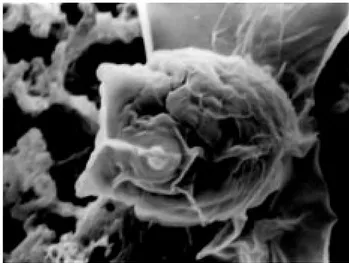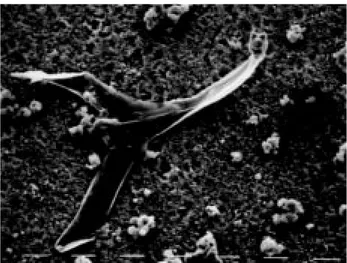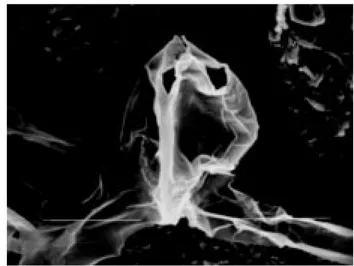Introduction
Actinosporeans are parasites of aquatic oligochaetes and have been known for a century (1). So far, more than 100 species or types of actinosporeans have been identified (2).
The taxonomy of actinosporeans is based on spore morphology and the taxonomy has been revised several times by several authors (3-7) Recently Kent et al. (8) redefined the phylum Myxozoa Grasse, 1970 to solve the taxonomic and nomenclatural problems arising from the two host life cycle of myxozoans as first described by Wolf and Markiw (9). The distinction between the two previously recognised classes Actinosporea and Myxosporea disappeared and the class Actinosporea was suppressed, becoming a synonym of the class Myxosporea Bütschli, 1881. The generic names of actinosporeans were retained as collective group names, and it was proposed that they be used to characterize different morphological types of actinosporeans. Actinosporeans, for which the myxosporean stage is not known, are to be
retained as species inquerandae until their specific identity is established. Quite recently, it was proposed by Lester et al. (10) that the International Code for Zoologean Nomenclature should be applied to newly described actinosporeans, so that genera and species of actinosporeans should be named even if no myxosporean stage is known. However, in a previous paper, Özer and Wootten (2) described actinosporeans as "types" with numbers according to Kent et al. (1994) to prevent future confusion in life cycle studies and for uniformity with other recently published descriptions of actinosporeans. The same description is also used in the present study for the reasons given above.
This study shows some additional observations obtained under SEM for several actinosporean types belonging to 5 different collective groups.
Materials and Methods
Oligochaetes infected with different actinosporean types were collected from an Atlantic salmon farm
Scanning Electron Microscopic (SEM) Observations on Some
Members of Actinosporean (Phylum Myxozoa) Collective Groups
and Possible Usage of SEM in Type Description
Ahmet ÖZER
Ondokuz May›s University, Fisheries Faculty, 57000, Sinop - TURKEY
Received: 17.10.2000
Abstract: In this study, eleven different actinosporean types belonging to the collective groups synactinomyxon, aurantiactinomyx-on, echinactinomyxaurantiactinomyx-on, raabeia and siedleckiella were observed under a scanning electron microscope (SEM) for the first time. The results obtained showed that surface structures and their ornamentation on the spore body and branches seen on the caudal process-es of actinosporean sporprocess-es are of importance in determination of the sporprocess-es, at least at the collective group level.
Key Words: Myxozoa, actinospore, Scanning Electron Microscope
Aktinospor (Filum: Myxozoa) Kollektif Gruplar›na Ait Baz› Bireylerin Taray›c› Elektron Mikroskobundaki Gözlemler ve Taray›c› Elektron Mikroskobunun Tip Tan›mlamas›nda
Muhtemel Kullan›m›
Özet: Bu araflt›rmada, synactinomyxon. aurantiactinomyxon, echinactinomyxon, raabeia ve siedleckiella kollektif gruplar›na ait 11 farkl› aktinospor tipi Taray›c› Elektron Mikroskobu'nda ilk defa incelendi. Elde edilen sonuçlar spor vucudundaki yüizeysel yap›lar ve ayak uzant›lar›ndaki dallanmalar›n, en az›ndan, kollektif grubunun belirlenmesinde önemli olabilece¤ini gösterdi.
photographed in a Philips 500 Scanning Electron Microscope.
Results
The results on the spore morphology obtained SEM showed that the individual spores of individual type could be differentiated from the other types in the same collective group as well as in the others. Apart from the measurement data, surface ornamentation on the spore body and the branches on caudal processes seen under SEM were also shown to be important additional characteristics for actinosporean collective groups.
Collective group synactinomyxon
In the present study, three different actinosporean types were studied: synactinomyxon type 1, type 2 and type 3, the first two of which are very close to each other in terms of the spore dimensions and appearances,
synactinomyxon types under study (Fig. 3). Very solid looking surface ridges surrounded the spore body.
Collective group aurantiactinomyxon
Two different aurantiactinomyxon types were examined under SEM in the present study. Aurantiactinomyxon type 1 and type 3 (see Ozer and Wootten (2) for type description) were similar in appearance but their morphological measurements differed. Aurantiactinomyxon type 1 had much less elongated caudal processes than type 3. Under light microscopy, the morphological appearance and the dimensions of Aurantiactinomyxon type 3 were also very similar to those of the members of the collective group Echinactinomyxon. However, at the SEM level, it was possible to obtain much more data on its morphology. The members of the collective group
Fig. 1. Synactinomyxon type 1 with surface ornamentation on the spore body and three polar capsules. (x2500)
Fig. 2 Caudal process connection point of synactinomyxon type 2 and the surface ridges on the spore body (x2500)
aurantiactinomyxon had a different surface ornamentation on the spore body and the surface ridges were very thin and in web-like structures. The surface ornamentation of the ridges can be seen in Fig. 4 for aurantiactinomyxon type 1 and in Fig. 5 for type 3.
Collective group echinactinomyxon
In the present study, of the six different echinactinomyxon types identified (see Ozer and Wootten (2) for type description), echinactinomyxon type 2 and type 5 were observed under SEM. Echinactinomyxon type 5 was recently shown to be the actinosporean stage of Sphaerospora truttae by Ozer and Wootten, (11). The spore body formed by the union of three valvogenic cells of echinactinomyxon type 2 and type 5 were observed to
be the only major ridges. There were not many minor surface ridges between the major ones on the spore body of both echinactinomyxon type 2 (Fig. 6) and echinactinomyxon type 5 (Fig. 7). In addition to the general appearance, both types also differed from each other due to the ornamentation of major and minor ridges on the spore body.
Collective group raabeia
In the present study, of the six different raabeia types identified (see Özer and Wootten, (2) for type description), raabeia type 1, type 3 and type 4 were observed at the SEM level. They were the representatives of three different appearances of the collective group.
Fig 3. Surface ridges with net-like appearance on the surface spore body of a synactinomyxon type 3 spore (`3000)
Fig. 4. Surface ornamentation on the spore body and three caudal processes of a aurantiactinomyxon type] spore. (x2500)
Fig 5. An individual spore of aurantiactinomyxon type 3 with many surface foldings on the spore body (x2500)
Fig. 6. Spore body of echinactinomyxon type 2 with solid surface ridges. (x2500)
Fig. 7. Spore body of echinactinomyxon type 5 with very dense surface ridges. (x2500)
Fig. 8. Side apical view of the spore body of a raabeia type 1 spore. Apart from major appearance of the sutural line formed by valvogenic cells, there are also several secondary surface ridges. (x2500)
Fig. 9. Four branches at the tip of one of the caudal processes of a raabeia type 1 spore. (x5000)
Fig. 10. An individual raabeia type 3 spore. Very elongated spore body with some surface ridges (x2500)
Release of sporoplasm from the spore body In the sporoplasm release process, at first, a polar filament release was observed (Fig. 14) and this was followed by the discharge of sporoplasm. Sutures of valves between the polar capsules opened and the sporoplasm discharged from this opening (Fig. 15) and surface ridges present on the spore body disappeared (Fig. 16).
Discussion
The results obtained in this study at the electron microscopic level suggested for the first time that SEM
could be a useful tool in the identification of actinosporean types, at least at the collective group level, by revealing details of the surface ornamentation on the spore body and the branches on the caudal processes.
The connection between the valves of the shell were prominent sutural ridges in all the actinosporean types examined in the present study and as was reported in the triactinomyxon stage of M. cerebralis (12). However, some secondary ridges on the shell were obvious under SEM and may have potential in the identification of actinosporean collective groups Under the light microscope, aurantiactinomyxon type 3 spores had similar features to members of the
Fig. 11. Several branches on one of the caudal processes of a raabeia type 4 spore. (x5000)
Fig. 12. An individual spore ofSiedleckiella silesica. Three caudal processes, an elongated style and three polar capsules are located on top of the endospore cavity. (x640)
Fig. 13. Closer look at the three polar capsules and the surface structures of an individual S. silesica spore. Note the polar filament discharge canal appearance. (x2500)
Fig. 14. Apical view of three polar capsules and two polar filaments already released. Note the opening between the septate junctions of three polar capsules of synactinomyxon type 3 spore (x5000)
collective group echinactinomyxon However, these secondary surface ridges on the spore body seen under SEM were minor in echinactinomyxon, while they were more abundant and numerous on aurantiactinomyxon spores, even obscuring the sutural ridges between the shell valves. The shape and the position of the polar capsules of aurantiactinomyxon type 3 were also different from the other actinosporean collective groups studied here. Thus, surface ornamentation might be of some value in differentiating actin-osporean types The secondary surface ridges were much heavier in synactinomyxon type 3 than in synactinomyxon type 1. In apical view, the three sutures of the shell valves formed a Y-shape at their intersection in all actinosporean types studied here, as was seen in the triactinomyxon stage of M. cerebralis
(12). The tips of the polar filaments were visible at the apertures at this intersection.
The patterns of the polar capsule and sporoplasm release observed in this study were similar to those observed from the triactinomyxon stage of M. cerebralis (12); polar filaments were first discharged, sutural ridges were opened and the sporoplasm released. During this sporoplasm release process, the spore body of synactinomyxon type 3 and the triactinomyxon stage spores of M. cerebralis lost the characteristic secondary surface ridges and the spore body became smoother. In all actinosporean types after full discharge of the sporoplasm, the three polar capsules were also released leaving empty spaces on top of the spore body, at which point recognition of the actinosporean type became impossible.
Fig. 15. An individual spore of synactinomyxon type 3 with a nearly discharged sporoplasm (x2500)
Fig. 16. Individual spore of echinactinomyxon type 2 after the sporoplasm was discharged. Note the plane surface of spore body apart from the valvogenic suture line. (x2500).
References
1. StoIc. A., Actinomyxidies. nouveau groupe de Mesozoaires parent des Myxosporidies. Bulletion of international de U Academia science Boheme 22: 1- 12, 1899
2. Ozer, A and Wootten, R., Actinosporean myxozoan spores belonging to the collective groups synact inomyxon, aurantiact inomyxon, raabeia, triactinomyxon, neoactinomyxum and siedleckiella from a freshwater salmon farm in Northern Scotland Folia Parasitol. (accepted for publication).
3. Ikeda, J., Studies on same sporozoan parasites of spinculoids I. The life history of a new Actinomyxidian, Tetractinomyxon intermedium g. et sp. nov. Archiv Für Protistenkunda 25: 240-242, 1912
4. Janiszewska, J , Actinomyxidia II. New systematics, sexual cycle, description of new genera and species. Zoologica Polonica 8: 3-34., 1957.
5. Levine, N D., Corliss, J. 0., Cox, F E. G., Deroux, G., Grain, J., Honinberg, B. M., Leedale, G. F., Loeblich, A. R.. Loin, J., Lynn, D., Merinfeld, E. G., Page, F. C., Polyanski, G., Sprague, V., Vavra. J., & Wallace, F. G., A newly revised classification of the Protozoa. Journal of Protozology 27: 3 7-58, 1980.
6. Sprague, V., Myxozoa. In: Synapsis and Classification of Living Organisms. Ed. Parker, S. P. McGraw - Hill Book Company, pp 595-597, 1982.
7. Lom, J., Phylum Myxozoa. In: Handbook of Protoctista. Ed. Margulis, L., Corliss, J.O., Melhonian, M. and Chapman, D.J. Jones and Barlett Publishers, Boston. pp. 36-52, 1990.
8. Kent, M. L., Margolis. L., & Corliss, J. 0., The demise of the class of protists: Taxonomic and nomenclatural revisions proposed for the protist phylum Myxozoa Grasse, 1970. Canadian Journal of Zoology 72: 932-937, 1994.
9. Wolf, K., & Markiw, M E., Biology contravenes taxonomy in the Myxozoa: new discoveries show alternation of invertebrate and vertebrate hosts. Science 225: 1449-1459, 1983
10. Lester, R. J C., Hallett, S L., EI-Matbouli, M & Canning, E U, The case for naming actinosporeans using the Zoological Code Parasitology Today 14. 476- 477, 1998
11. Özer, A & Wootten, R, The life cycle of Sphaerospora truttae (Myxozoa: Myxosporea) and some features of the biology of both the actinosporean and myxosporean stages. Diseases of Aquatic Organisms, 40: 33-39, 2000.
12. EI-Matbouli, M, Hoffmann, R.W., Schoel, E., McDowell, T.S. and Hedrick, R.P., Whirling disease host specificity and interaction between the actinosporean stage of Myxobolus cerebralis and rainbow trout Oncorhynchus mykiss. Diseases of Aquatic Organisms 35: 1 - 12, 1999.

![Fig. 4. Surface ornamentation on the spore body and three caudal processes of a aurantiactinomyxon type] spore](https://thumb-eu.123doks.com/thumbv2/9libnet/4027220.55948/3.892.442.787.103.365/fig-surface-ornamentation-spore-caudal-processes-aurantiactinomyxon-spore.webp)


